Bristol Beaufighters
Mk.IF, Mk.IC & Mk.VI
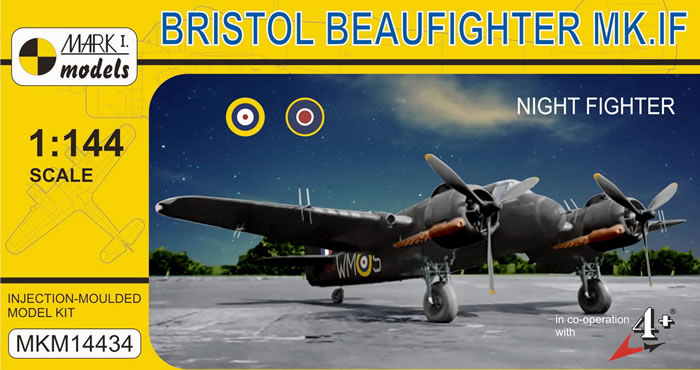
Mark 1 Models, 1/144 scale
S u m m a r y : |
Catalogue Number: |
Mark 1 Models Kit Nos.:
MKM14434 - Bristol Beaufighter Mk.IF “Night Fighter”
MKM14435 - Bristol Beaufighter Mk.IC “Coastal Patrol”
MKM14436 - Bristol Beaufighter Mk.VI “Formidable Fighter” |
Scale: |
1/144 |
Contents & Media: |
55 grey and six clear styrene parts per kit; plus waterslide decals covering four aircraft with each boxing. |
Price: |
Available online from: |
Stockist |
Mk.IF |
Mk.IC |
Mk.VIF/C |
Hannants |
£12.49 |
£12.49 |
£12.49 |
Modelimex |
€15.08 |
€15.08 |
€15.08 |
Hobby Link Japan |
¥2610 |
¥2610 |
¥2610 |
Click here for currency conversion. |
Review Type: |
First Look. |
Advantages: |
First injected 1/144 Beaufighter kits, good finesse and subtle detail for the scale, clear wing-tips are a nice touch. |
Disadvantages: |
None noted. |
Conclusions: |
These three are all superb kits of a popular subject, and the first injected kits in 1/144 scale. Surface detail is exquisitely done, whilst interior detail is more than adequate. A high degree of overall scale refinement has been achieved despite the moulding limitations the small scale imposes on tool-makers. Some touches like the clear wingtips and undercarriage door detail provide lessons to makers of larger scale kits.
Clear instructions, nice colour schemes, and excellent decals only serve to reinforce the overall quality of these kits.
Neatly finished, these latest releases from Mark I Models have the potential to produce little gems that will be very undemanding on display space. All three boxings are highly recommended. |
Reviewed by
Mark Davies

Sword's 1/72 scale scale Gannet AEW.3 is available online from
Squadron.com
The Bristol Beaufighter was a British long-range heavy fighter, developed early in 1939 from the Beaufort torpedo bomber. It became an efficient night-fighter, employing the then novel AI radar. Following short-term development the first prototype flew in July 1939 and the first aeroplanes reached the squadrons in the summer of the next year.
The Beaufighter was a two-seat, twin engine, all-metal mid-wing cantilever monoplane, fitted with a retractable undercarriage. It was powered by two Hercules radial engines and the armament consisted of four cannons in the nose, four guns in the starboard wing and another two guns in the port wing.
The Beaufighter Mk.IF was destined for RAF Fighter Command units, while the Mk.IC, fitted with an additional radio and navigational equipment, was a dedicated long-range fighter for the Coastal Command. Total production of both variants reached 914 aircraft.
The Beaufighter had a long career and served in almost all theatres of war during the WWII, at first as a night fighter, then as a fighter-bomber and eventually being used as a torpedo-bomber.
Source: Mark I Ltd
Click on this Wikipedia linkfor a more detailed account of the Beaufighter’s development and operational history.
Mark I Ltd is well known for their 4+ range of aviation booklets, Mark I Guides and decal sets, the CMR range of resin kits, and the Attack Hobbies 1/144-scale range of jet aircraft. This last range was re-boxed and released with new decals, along with two ex-Eduard 1/144 kits of the Bf 109G & Fw 190A. Mark I has also released its own new tool 1/144-scale kits covering different versions of the Westland Wessex, Heinkel He 219, Focke-Wulf Ta 152H, and now the Bristol Beaufighter.
This is the first time that the Beaufighter has been offered as an injected kit in 1/144 scale, and so is sure to be welcomed by fans of this small scale.
Contents
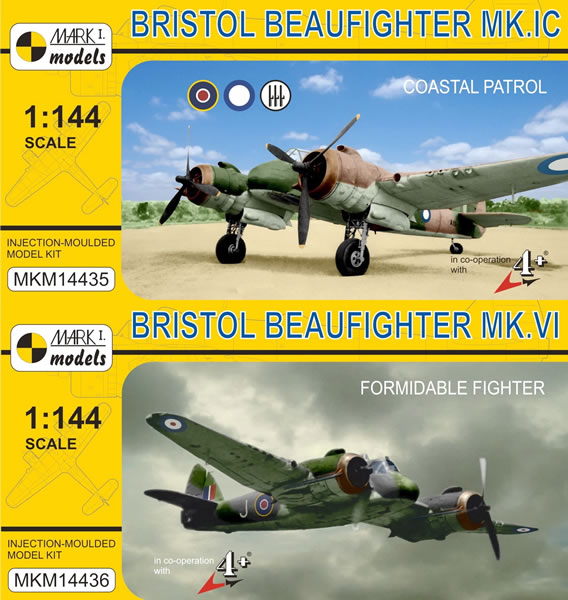
Each of the kits comes packed in a good quality end-opening box with nice artwork on the front and colour profiles on its rear. All parts are sealed in a plastic bag with the instructions and decals, and the clear parts are further enclosed in their own small bag.

The instructions are formed by a fold-out sheet with colour printing. They include a parts map and clear assembly diagrams that are easy to follow. All text is in English, with detail colour call-outs included.
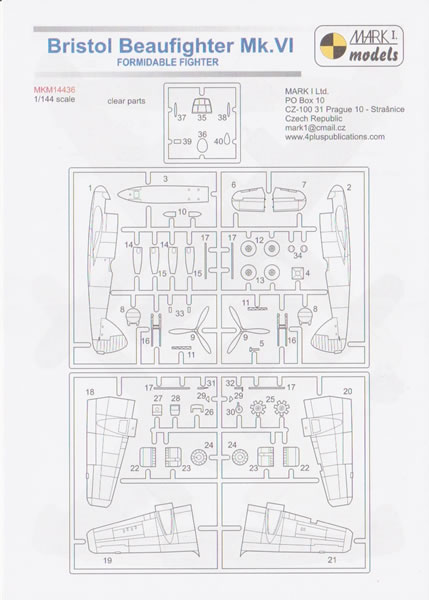
The instructions include a four-view coloured painting & markings guide for each option, with RAF colour names used for the main airframe colours.
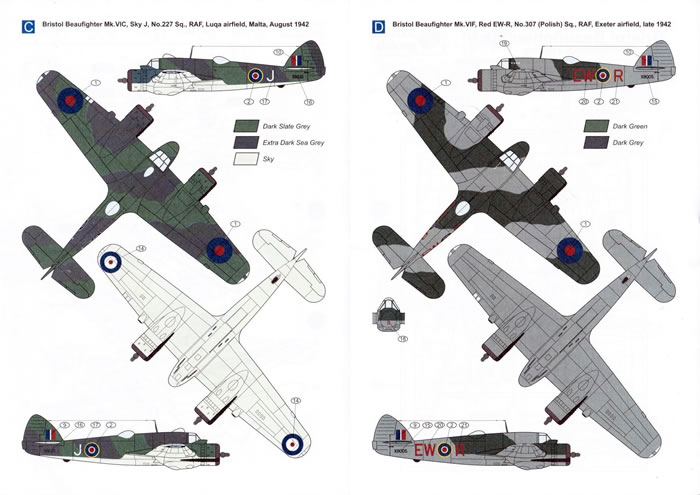
The Kits
Each kit has the same styrene components, but obviously uses different decals and suitable variations in the instructions and colours & markings guides for the version concerned. All parts are very crisply moulded, with delicate panel line and fabric control surface detail that is superb for the scale.
The kit follows a conventional breakdown for this type of aircraft.
The cockpit is formed from a floor running between the two crew positions, with a seat for each. The pilot’s position also has an instrument panel, side consoles and delicate control column with “spectacle” hand-holds. The detail seems quite adequate for this small scale, although some may opt to add the prominent heating duct that ran along the inside of the fuselage. The canopies are clear and thin, and there should be little distortion when viewing the interior.
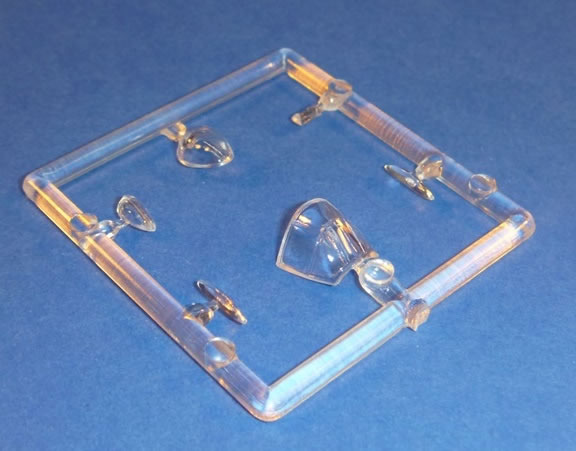
The wings are split top and bottom, and some thinning of trailing edges is worthwhile for better scale appearance; despite being commendably thin already, moulding limitations in this scale means that there is still room for improvement. A very nice touch, that larger scales could offer more regularly, are the clear wing-tips which when masked will allow for navigation lights. A clear leading-edge landing light is also provided. Oil cooler intakes are separate parts that fit to the leading edge of each wing, which also have the six .303 machinegun blast holes moulded in place (Note: These are not applicable to the first 50 Mk.1’s built however).
The Hercules engines have both rows of cylinder provided, and will look fine once enclosed in their cowls and fronted by some finely done props. Alternate hedgehog and short-plane exhausts are provided.
Engine firewalls are supplied for the cowls to butt onto, and these also provide the interior face of the main wheel-wells with mounting points for the undercarriage. The undercarriage is very nicely executed, simultaneously managing to look delicate for the scale but robust like the original. The wheels have crisply moulded hub detail, whilst the undercarriage doors are very nicely detailed, with their internal structure represented as well as the internal bulge to clear the tyres. This door detail more than makes up for the slightly, and unavoidable, over-scale thickness of the parts. The nacelles are capped off by separate carburettor-air intakes.
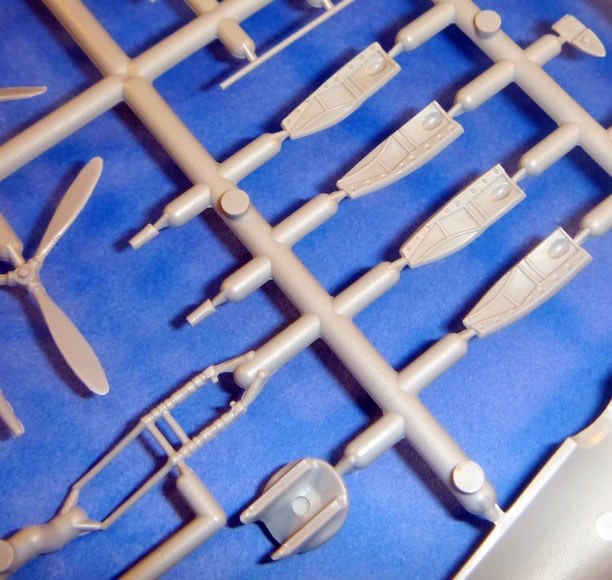
No radar antennae are provided for the night fighter boxing as obviously these parts need to be too fine to be moulded, or indeed supplied as PE parts. Surprising however is that the instructions make no mention of scratch-building these using stretched sprue (although their location are indicated on the box art).
The overall quality is excellent, and the kit should prove easy to assemble despite its small size. It is the equal of Sweet’s 1/144 aircraft kits; which I think have previously set the benchmark for WW2 fighters in this scale.

Colours and Markings
MKM14434 - Bristol Beaufighter Mk.IF “Night Fighter”:
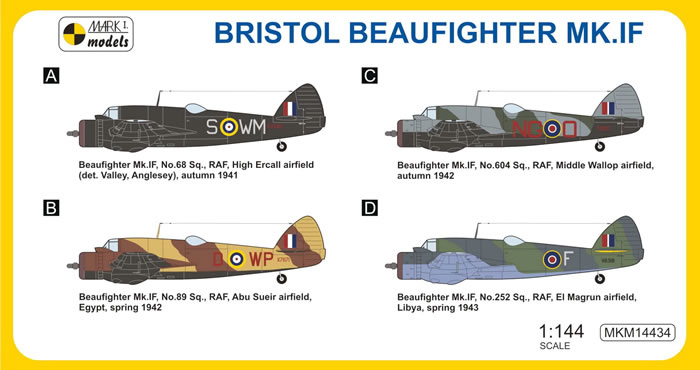

MKM14435 - Bristol Beaufighter Mk.IC “Coastal Patrol”:
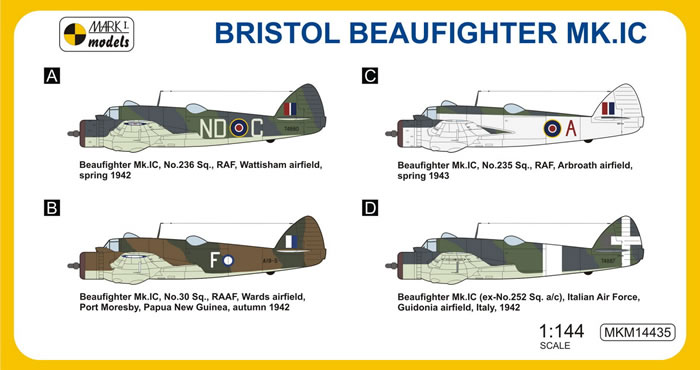
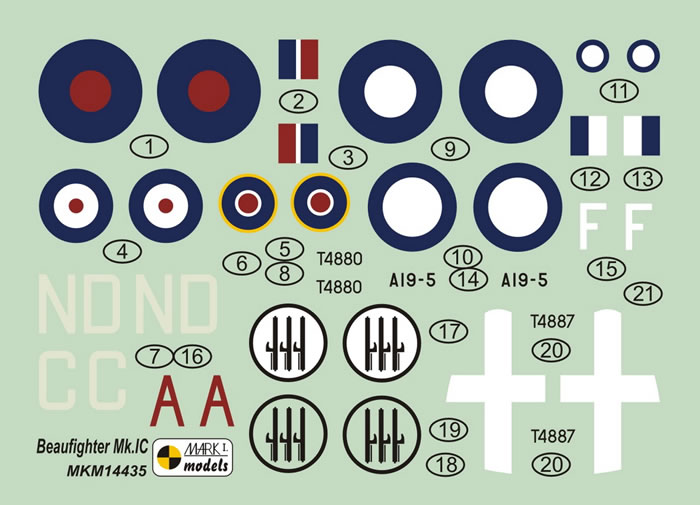
MKM14436 - Bristol Beaufighter Mk.VI “Formidable Fighter”:
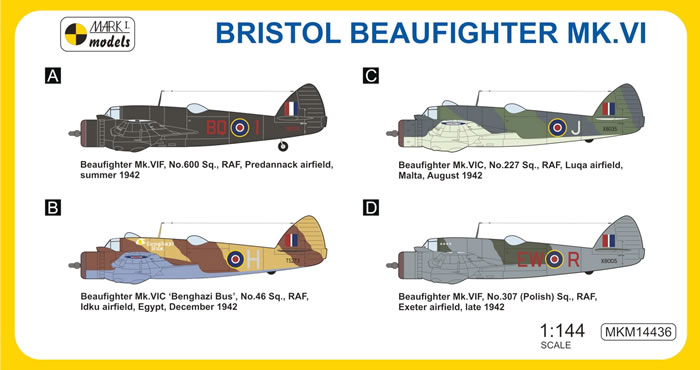
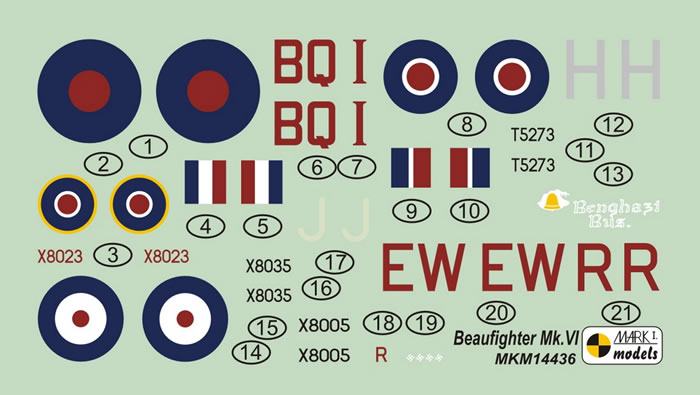
The decals appear to be excellent, as we would expect given the company's background in decal production.
These three are all superb kits of a popular subject, and the first injected kits in 1/144 scale. Surface detail is exquisitely done, whilst interior detail is more than adequate. A high degree of overall scale refinement has been achieved despite the moulding limitations the small scale imposes on tool-makers. Some touches like the clear wingtips and undercarriage door detail provide lessons to makers of larger scale kits.
Clear instructions, nice colour schemes, and excellent decals only serve to reinforce the overall quality of these kits.
Neatly finished, these latest releases from Mark I Models have the potential to produce little gems that will be very undemanding on display space. All three boxings are highly recommended.
Thanks to Mark I Ltd for the review sample.
Review Text & Blue Background Images Copyright © 2015 by Mark Davies
Page Created 14 September, 2015
Last updated
14 September, 2015
Back to HyperScale Main Page

|
